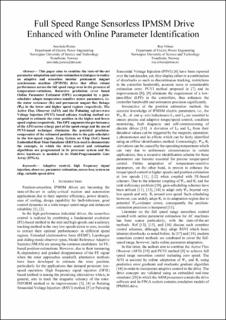| dc.contributor.author | Perera, Aravinda | |
| dc.contributor.author | Nilsen, Roy | |
| dc.date.accessioned | 2022-04-01T12:22:10Z | |
| dc.date.available | 2022-04-01T12:22:10Z | |
| dc.date.created | 2022-01-17T09:44:47Z | |
| dc.date.issued | 2021 | |
| dc.identifier.isbn | 978-1-6654-0510-2 | |
| dc.identifier.uri | https://hdl.handle.net/11250/2989309 | |
| dc.description.abstract | This paper aims to combine the state-of-the-art parameter-adaptation and state-estimation techniques to realize an adaptive and sensorless interior permanent magnet synchronous machine (IPMSM) drive that offers robust performance across the full speed range even in the presence of temperature-variations. Recursive prediction error based Online Parameter Estimator (OPE) accompanied by a gain-scheduler adapts temperature-sensitive motor parameters, i.e. the stator resistance (R s ) and permanent magnet flux linkage ( Ψm) in the lower and higher speed regions respectively. The Active Flux Observer (AFO) and the Pulsating sqUare-wave Voltage Injection (PUVI) based saliency tracking method are adopted to estimate the rotor position in the higher and lower speed regions respectively. The OPE augments the performance of the AFO across a large part of the speed-range and the use of PUVI-based technique eliminates the potential precision-compromise of the estimated position due to the gain-scheduler in the low-speed region. Zynq System on Chip (SoC) based Embedded Real-Time Simulator (ERTS) is used to demonstrate the concepts, in which the drive control and estimation algorithms are programmed in its processor system and the drive hardware is modeled in its Field-Programmable Gate Array (FPGA). | en_US |
| dc.language.iso | eng | en_US |
| dc.publisher | Institute of Electrical and Electronics Engineers (IEEE) | en_US |
| dc.relation.ispartof | 2021 IEEE International Electric Machines & Drives Conference (IEMDC) | |
| dc.title | Full Speed Range Sensorless IPMSM Drive Enhanced with Online Parameter Identification | en_US |
| dc.type | Chapter | en_US |
| dc.description.version | acceptedVersion | en_US |
| dc.rights.holder | © IEEE. Personal use of this material is permitted. Permission from IEEE must be obtained for all other uses, in any current or future media, including reprinting/republishing this material for advertising or promotional purposes, creating new collective works, for resale or redistribution to servers or lists, or reuse of any copyrighted component of this work in other works. | en_US |
| dc.identifier.doi | 10.1109/IEMDC47953.2021.9449562 | |
| dc.identifier.cristin | 1982208 | |
| cristin.ispublished | true | |
| cristin.fulltext | postprint | |
